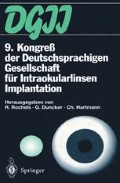Zusammenfassung
In einer prospektiv randomisierten Studie wurde die pH-Abhängigkeit der Penetration von Lidocain durch die Kornea und sein anästhetischer Effekt im Rahmen von Katarakt-operationen geprüft. 16 min nach Eintropfen einer 4% Lidocainlösung von pH 7,2 betrug die Lido-cainkonzentration im Kammerwasser 15,1 ± 8,2 μg/ml. Bei Verwendung der konventionellen 4%-Lidocainlösung von pH 5,2 war die Konzentration im Kammerwasser zum selben Zeitpunkt mit 4,8 ± 3,4 μg/ml statistisch signifikant geringer. Diese pH-Abhangigkeit der Penetration von Lidocain durch die Kornea ist in Übereinstimmung mit nichtionischer Diffusion. Keine signifikante Gruppendiffe-renz wurde beim subjektiven Schmerzempfinden sowie bei den postoperativen Befunden erhoben.
Summary
In a prospective randomized study we examined the influence of pH on the corneal penetration and anesthetic action of lidocaine during cataract operations. 16 mins after application of topical lidocaine 4%, pH 7.2, a mean aqueous lidocaine concentration of 15.1 ± 8.2 μg/ml was found. After instillation of standard topical lidocaine 4%, pH 5.2, the concentration of lidocaine in the aqueous at the same time was statistically significant lower: 4.8 α 3.2 μg/ml. The pH dependence of lidocaine’s corneal penetration is in correspondence with the concept of nonionic diffusion. No significant differences between the two groups could be found regarding subjective pain and postoperative measurements.
Access this chapter
Tax calculation will be finalised at checkout
Purchases are for personal use only
Preview
Unable to display preview. Download preview PDF.
Literatur
Draeger J, Langenbucher H, Bannert W (1994) Efficacy of topical anaestetics. Ophthalmic Res 16: 135–138
Gills JP, Hustead RF, Sanders DR (1993) Ophthalmic anesthesia. Slack, Thorofare, pp 69–102
Lewis P, Hamilton RC, Brant R, Loken RG, Maltby JR, Strunin L (1992) Comparison of pain with pH-adjusted bupivacaine with hyaluronidase for peribulbar block. Can J Anaesth 39: 555–558
Marr WG, Wood R, Senterfit L, Sigelman S (1957) Effect of topical anesthetics. Am J Ophthalmol 43: 606–610
Mauger TF, Craig EL (1994) Havener’s Ocular Pharmacology, 6 edn., Mosby, St. Louis, p 40
Salomon F, Körprich R, Biscoping J, Strobel J (1990) Lokalanaesthetika im Kammerwasser bei örtlicher Betäubung am Auge. Klin Monatsbl Augenheilkd 196: 26–29
Sarvela PJ, Paloheimo MP, Nikki PH (1994) Comparison of pH-adjusted bupivacaine 0.75% and a mixture of bupivacaine 0.75% and lidocaine 2%, both with hyaluronidase, in day-case cataract surgery under reginal anesthesia. Anesth Analg 79: 35–39
Zahl K, Jordan A, McGroarty J, Sorensen B, Gotta A (1991) Peribulbar anesthesia — Effect of bicarbonate on mixtures of lidocaine, bupivacaine, and hyaluronidase with or without epinephrine. Ophthalmology 98: 239–242
Editor information
Editors and Affiliations
Rights and permissions
Copyright information
© 1995 Springer-Verlag Berlin Heidelberg
About this paper
Cite this paper
Zehetmayer, M. et al. (1995). pH-Abhängigkeit der Penetration von Lidocain 4% durch die Kornea im Rahmen der Tropfanästhesie. In: Rochels, R., Duncker, G., Hartmann, C. (eds) 9. Kongreß der Deutschsprachigen Gesellschaft für Intraokularlinsen Implantation. Springer, Berlin, Heidelberg. https://doi.org/10.1007/978-3-642-93570-1_59
Download citation
DOI: https://doi.org/10.1007/978-3-642-93570-1_59
Publisher Name: Springer, Berlin, Heidelberg
Print ISBN: 978-3-642-93571-8
Online ISBN: 978-3-642-93570-1
eBook Packages: Springer Book Archive

